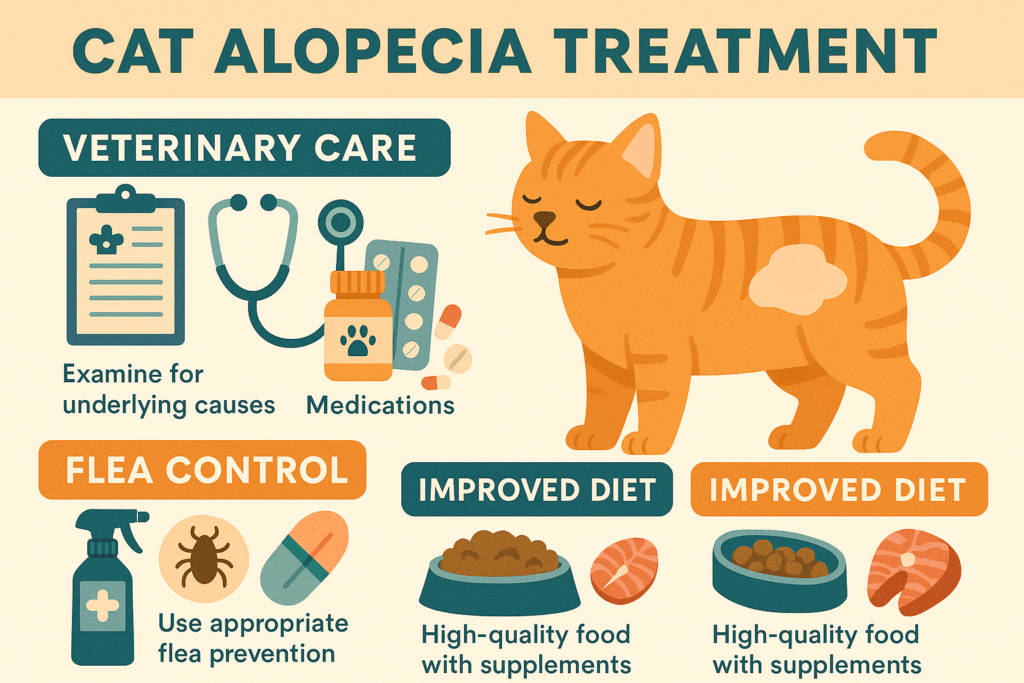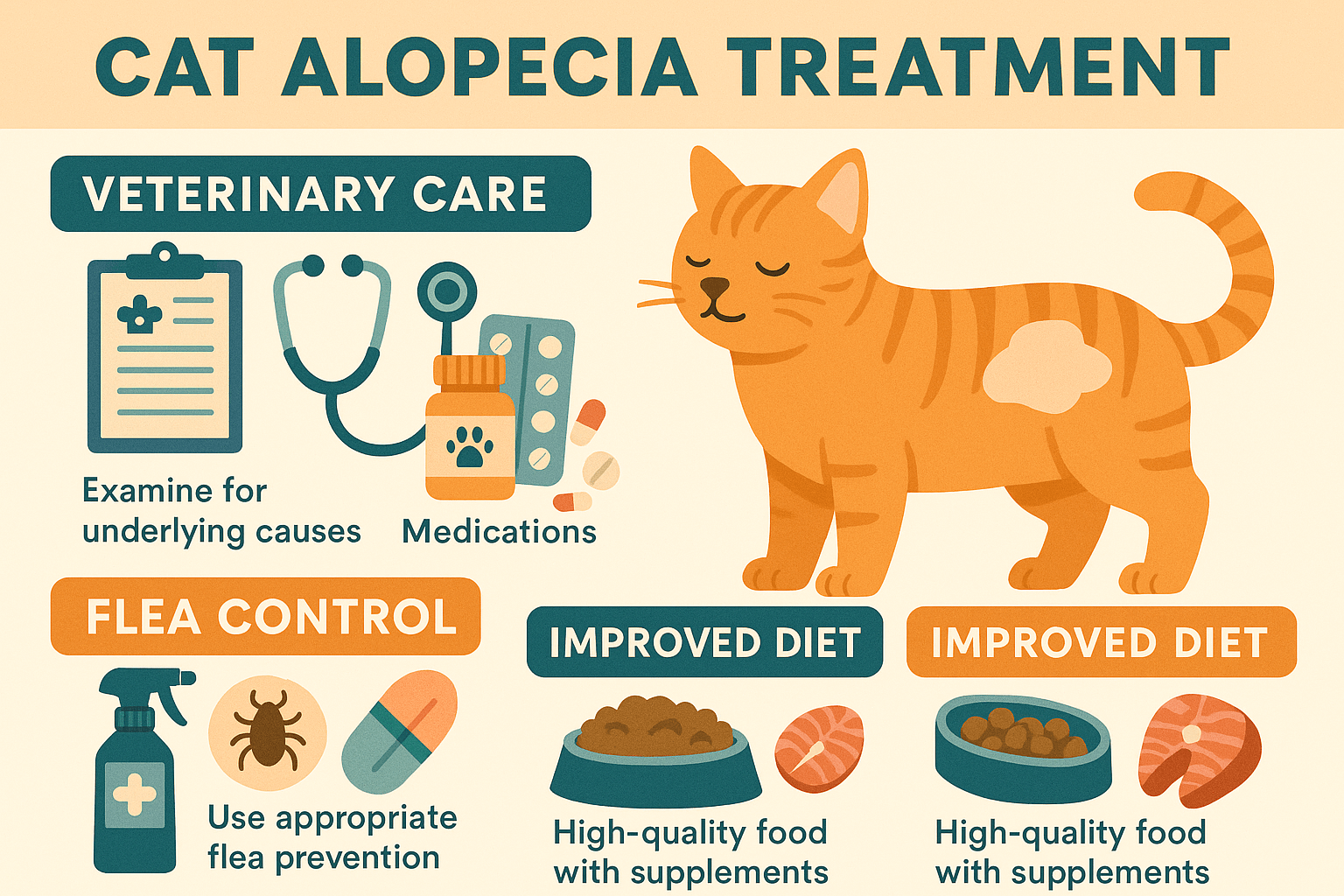Cat Alopecia Treatment: Restoring Your Feline’s Coat and Confidence
Alopecia, or hair loss, in cats can be alarming for pet owners. Whether caused by allergies, stress, parasites, or underlying health conditions, this condition not only affects your cat’s appearance but also their comfort and well-being. Fortunately, effective treatments are available to address alopecia and help your feline friend regain a healthy, shiny coat. Understanding the causes, symptoms, and treatment options is key to providing the best care for your cat. In this guide, we’ll explore everything you need to know about cat alopecia treatment, from identifying triggers to implementing solutions that promote healing and recovery.
Expert Insight on Cat Alopecia
“When cats experience alopecia, they lose thick tufts of fur in various locations throughout their bodies, leaving exposed skin. Cats may develop alopecia due to genetics, underlying health conditions, or stress and anxiety.”
Common Causes of Cat Alopecia
To effectively treat alopecia in cats, it’s essential to identify its root cause. Hair loss can stem from a variety of factors, ranging from environmental triggers to medical conditions. Here are some common culprits behind feline alopecia:
Allergies:
Cats can develop allergies to food, fleas, or environmental irritants like pollen or dust mites, leading to excessive scratching and hair loss.Parasitic Infestations:
Fleas, ticks, and mites (such as those causing mange) can irritate your cat’s skin, prompting them to over-groom and lose fur.Hormonal Imbalances:
Conditions like hyperthyroidism or Cushing’s disease may disrupt hormone levels, resulting in patchy hair loss.Stress or Anxiety:
Psychological factors, such as changes in routine or environment, can trigger compulsive grooming behaviors that lead to alopecia.Infections:
Bacterial or fungal infections, such as ringworm, can damage the skin and cause significant hair loss if left untreated.
Pinpointing the exact cause of alopecia is crucial for tailoring an appropriate treatment plan and addressing any underlying issues.

Steps to Diagnose Cat Alopecia
Before beginning treatment, your veterinarian will need to diagnose the specific cause of your cat’s alopecia. This process involves several steps to ensure an accurate understanding of the condition.
Physical Examination:
Your vet will inspect your cat’s skin and coat for signs of irritation, redness, scabs, or unusual patterns of hair loss.Skin Scrapings and Tests:
A sample of your cat’s skin may be analyzed under a microscope to check for parasites, fungi, or bacteria.Blood Tests:
Blood work can reveal hormonal imbalances, nutritional deficiencies, or systemic diseases contributing to alopecia.Dietary Review:
Evaluating your cat’s diet helps identify potential food allergies or nutrient deficiencies that could be affecting their coat health.Behavioral Assessment:
Observing your cat’s grooming habits and overall demeanor can highlight stress-related causes of hair loss.
By thoroughly diagnosing the issue, your vet can recommend targeted treatments that address the root cause of your cat’s alopecia.
Check this guide 👉Cat Losing Hair on Back Legs: Best 7 Expert Tips!
Check this guide 👉Cat Losing Hair on Belly: Best 7 Expert Tips!
Check this guide 👉Cat Losing Hair on Belly: Best 7 Expert Tips!
Treatment Options for Cat Alopecia | Preventative Measures |
|---|---|
Medicated shampoos for skin infections | Regular flea prevention and grooming |
Prescription diets for food allergies | Stress reduction through environmental enrichment |
Hormone therapy for imbalances | Providing a balanced, high-quality diet |
Antifungal medications for ringworm | Monitoring for early signs of skin issues |
Parasite control treatments | Keeping living spaces clean and allergen-free |
Effective Treatments for Cat Alopecia
Once the cause of alopecia has been identified, your veterinarian can recommend a tailored treatment plan. These interventions aim to alleviate symptoms, heal the skin, and restore your cat’s coat.
Medicated Shampoos and Topical Treatments:
Specialized shampoos and creams can soothe irritated skin, combat infections, and reduce inflammation.Anti-Parasitic Medications:
Flea and tick preventatives or anti-mite treatments eliminate parasites responsible for hair loss.Dietary Adjustments:
Switching to hypoallergenic or prescription diets can address food allergies and improve overall coat health.Hormonal Therapies:
In cases of hormonal imbalance, medications or supplements may be prescribed to regulate hormone levels.Behavioral Interventions:
Reducing stress through environmental changes, interactive play, or calming products can curb excessive grooming.
With consistent treatment, most cats see significant improvement in their coat condition and overall well-being.
Home Care Tips for Managing Cat Alopecia
While professional treatment is essential, there are several steps you can take at home to support your cat’s recovery and prevent future episodes of alopecia.
Maintain a Clean Environment:
Regularly clean your home to minimize exposure to allergens and irritants that could trigger hair loss.Provide Mental Stimulation:
Toys, puzzles, and climbing structures help reduce stress and redirect your cat’s focus away from over-grooming.Monitor Grooming Habits:
Keep an eye on how often your cat grooms themselves and intervene if you notice obsessive licking or chewing.Use Gentle Grooming Tools:
Brush your cat’s coat regularly to remove loose fur and distribute natural oils, promoting healthier skin and fur.Schedule Routine Vet Check-Ups:
Regular veterinary visits allow for early detection of potential issues before they escalate into severe alopecia.
Combining professional care with attentive home management ensures your cat stays happy and healthy.
Signs Your Cat May Have Alopecia
Recognizing the early signs of alopecia can help you seek treatment promptly, preventing further complications. Look out for these indicators that your cat may be experiencing hair loss:
Patchy Bald Spots:
Noticeable areas of missing fur, especially around the belly, legs, or tail, are classic signs of alopecia.Excessive Licking or Chewing:
If your cat obsessively licks or chews certain areas, it may indicate discomfort or irritation.Red or Inflamed Skin:
Redness, swelling, or scabs beneath bald patches suggest an underlying skin issue.Changes in Behavior:
Increased agitation, restlessness, or withdrawal may signal discomfort related to alopecia.Visible Parasites:
Fleas, ticks, or mites crawling on your cat’s skin point to parasitic infestations as a possible cause.
Early detection allows for timely intervention, improving your cat’s chances of a speedy recovery.
Nutritional Support for Healthy Coats
A balanced diet plays a vital role in maintaining your cat’s coat health and preventing alopecia. Incorporating these nutritional strategies can support their overall well-being:
High-Quality Protein Sources:
Protein is essential for healthy fur growth; ensure your cat’s diet includes meat-based proteins.Omega-3 Fatty Acids:
Fish oil or flaxseed supplements can improve skin hydration and reduce inflammation.Vitamins and Minerals:
Nutrients like biotin, zinc, and vitamin E promote strong, shiny coats.Hydration:
Encourage water intake to keep your cat’s skin hydrated and less prone to dryness or flakiness.Limited Fillers and Additives:
Avoid foods with artificial colors, flavors, or excessive carbohydrates, which can contribute to allergies.
Proper nutrition lays the foundation for a glossy coat and reduces the risk of alopecia.
When to See a Veterinarian
Knowing when to consult a veterinarian is critical for addressing alopecia effectively. Certain situations warrant immediate professional attention to protect your cat’s health.
Sudden or Severe Hair Loss:
Rapid or widespread alopecia should never be ignored, as it may indicate a serious underlying condition.Signs of Pain or Discomfort:
If your cat appears to be in pain or avoids being touched, seek veterinary care promptly.Persistent Itching or Scratching:
Continuous scratching despite initial treatments suggests the need for further investigation.Unexplained Weight Loss or Lethargy:
These symptoms alongside alopecia could point to systemic illnesses requiring urgent diagnosis.Failure to Improve with Home Care:
If home remedies or over-the-counter solutions don’t yield results, professional intervention is necessary.
Timely veterinary care ensures your cat receives the appropriate treatment for their specific needs.
Frequently Asked Questions About Cat Alopecia Treatment
What causes alopecia in cats?
Alopecia can result from allergies, parasites, hormonal imbalances, stress, or infections. Identifying the exact cause requires veterinary diagnosis.
Can alopecia be cured?
Yes, many cases of alopecia can be successfully treated once the underlying cause is addressed.
Is alopecia painful for cats?
Depending on the cause, alopecia may be accompanied by itching, irritation, or discomfort, which can affect your cat’s quality of life.
How long does it take for a cat’s fur to grow back?
Fur regrowth typically takes several weeks to months, depending on the severity of the condition and the effectiveness of treatment.
Can I prevent alopecia in my cat?
While not all cases are preventable, maintaining good hygiene, reducing stress, and providing a balanced diet can lower the risk of alopecia.
Restoring Your Cat’s Health and Happiness
Cat alopecia is more than just a cosmetic concern—it’s a sign that something may be amiss with your feline’s health or environment. By understanding the causes, seeking professional guidance, and implementing proper care, you can help your cat overcome alopecia and enjoy a full, vibrant coat once again. Remember, patience and consistency are key when treating this condition. With love, attention, and the right approach, your cat will soon be back to their playful, confident self.
Understanding Bone Supplement for Cats: Best 7 Expert Tips! – Safe, vet-approved guidance for strong feline bones & balanced nutrition.
Bone Supplement for Dogs: Best 7 Expert Tips! – Expert guide to calcium, collagen & bone health for every life stage.
Understanding Can Cats Get Sunburn: Best 7 Expert Tips! – Protect your feline from UV damage with vet-backed prevention strategies.
How to Train a Seizure Alert Dog: Best 7 Expert Tips! – Learn expert-backed steps to nurture natural instincts into reliable, life-saving seizure alerts.





